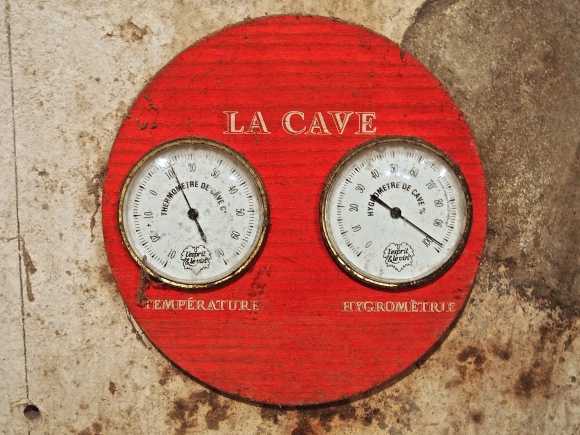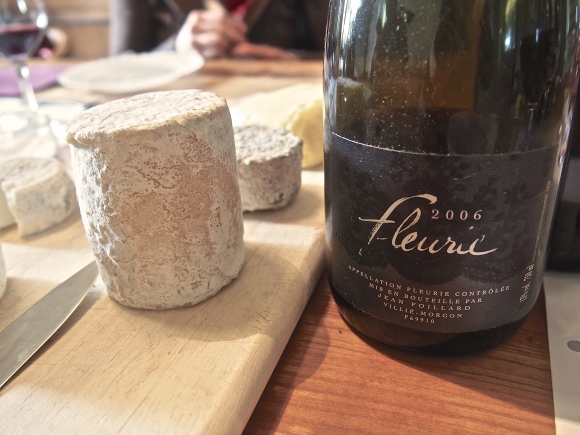– Back in the day farmers used to spray their fields with toxic chemicals and when their plastic containers became empty, they burned them at the site, tells Christophe Pacalet, shaking his head and laughing.
As an aspiring producer of natural wine, Christophe Pacalet embodies the undiluted version of the Beaujolais region – the one that everybody is currently talking about. The Beaujolais that is about respecting the environment and the local traditions alike. The results are nothing short of stunning, as I’m just about to find out.

Monsieur Pacalet pouring his 2012 Fleurie from the barrel
Though Christophe Pacalet carries himself with notable modesty and doesn’t make too much noise about himself, he is not an ordinary farmer guy. Well he is, but at the same time he isn’t. He is the nephew of the late Marcel Lapierre who was considered the pioneer of the natural wine movement which has received a lot of worldwide attention in the past few years. Though originally a chef, when Christophe decided to become a vigneron, he learned the ropes from the best.
The last vintage of Beaujolais, the 2012, was a difficult one with almost all possible problems, from frost to hail and to mildew. A catastrophe from the viewpoint of volume. Some producers, like Domaine de la Grand’Cour, got only 15% percent of the yield they usually get. Jean-Louis Dutraive was able to produce tasty wines, but economically speaking situation is obviously dire. The fact that it was raining cats and dogs most of my time in Beaujolais makes one hope that the 2012 doesn’t repeat itself.
But let’s get back to the cellar of Christopher Pacalet. He pours me a glass of his 2012 from the small cru of Chiroubles, located at a higher altitude than other nine Beaujolais crus. It is a tightly knit and vibrant wine, the kind of firm but succulent interpretation of Gamay that cleans your palate without drying your mouth and is at the same time able to appeal to you in a more thoughtful way. Rare quality in the world of wine, though pleasingly often available with high quality Cru Beaujolais.

– I want to make the same kind of wines my grandfather used to. That means hands off approach. Well almost like my grandfather. Sometimes his wines turned into vinegar, which hasn’t happened to me, he laughs.
– Back then people didn’t understand the fermentation process thoroughly. Working with the vines was more difficult too. For example, mildew was a huge problem. That’s why they built the chapel on top of Fleurie, next to the famous vineyards of La Madone. They used to pray in the chapel so that mildew would stay away, Christophe explains.
That fact tells you something quite essential about the region in itself but especially about the relation of its people to wine. The chapel on top of Fleurie was built to gain divine protection for the vines, not for the people. I kind of like the idea.
Marcel Lapierre, or uncle, as Christophe calls him, was one of the unpretentious pioneers who were able to change the image of Beaujolais with their own example. Lapierre was among first to travel vastly abroad. It was no coincidence that it lead to a revolution of quality.
– When he came back he was full of new ideas. This was in the late seventies, Christophe says.
As paradoxical as it may sound, the ones who wanted to go back to the traditional methods were the ones who’d been around the world most.

Rusty indicator at Domaine de la Grand’Cour
The quiet revolution that was ignited by Lapierre has made Beaujolais one of the most interesting wine regions of France at the moment. Thanks to him and people like Foillard, Metras, Balagny, Brun, Dutrieve and Pacalet, the story in the wine media is no longer one of declining sales of Beaujolais nouveau but of the new Beaujolais, that has gone natural.
– The generation before me didn’t choose. They didn’t decide to become vignerons. They were born into families making wine and become vignerons because of that. That’s the big difference with today. If someone makes wine now, he or she has chosen it independently. It’s not the easiest way to make money, so many of the people who do it today, do it properly, Christopher tells.
Indeed, passion seems to have come back to Beaujolais. The region is full of aspiring producers making interesting wines, like Sunier, Jambon, David-Beaupère and Thillardon.

The young guys of Beaujolais
But now that nouveau was mentioned, let’s talk about that for a minute here. Nouveau seems to be the blessed curse of the region. It has made some people rich but at the same time destroyed the quality image of the whole region. I see Beaujolais Nouveau as a typical short term gain, long term loss –situation leading towards all kinds of trouble, but the locals seem to be more forgiving towards it.
– Well it did make the region famous worldwide, says the great Jean-Paul Brun before continuing that it however might be one of the reasons why a Moulin-à-Vent goes for one tenth of the price of a Vougeot from neighboring Burgundy, though they used to be at same price level a hundred years ago. Yes, that might have something to do with it.
Cédric Chignard, the wine maker of the brilliant Fleurie company Chignard making wines with piercing purity and long aging potential puts it the other way around.
– The problem is not in my opinion the nouveau. The problem is the crus. They’ve been badly marketed, Cédric says.
The man does have a point there. The majority of Bordeaux is cheap low quality wine, but no-one thinks that would affect the image of Pauillac crus.

Foillard is one of the very best in the region. Here having a lunch with the family
Christopher Pacalet seems to agree with Cédric Chignard, since Christophe too makes nouveau. In fact 50% of his production is nouveua and especially the Japanese are crazy about it. But one shouldn’t confuse his nouveau with the thermovinificated industrial stuff the big houses push out. We are talking here natural nouveau. If it sounds crazy, listen to this:
– I’d want to put my wine into a bag-in-a-box. Why not? Natural nouveau in a box, imagine that, he says.
I try to, but the whole concept sounds almost too out of the box, pun intended. After chewing on the idea for a while, I start to like it. Especially the idea of drinking Pacalet’s nouveau. Maybe this could be my ticket back to world I’ve actively avoided for many years?

Yvon Metras is a living legend and a true character. His car on the other hand, is an environment crime on wheels
The low quality industrial nouveau is mostly to blame for the situation many Beaujolais producers are currently facing. Since nouveua isn’t selling anymore like it used to, producers that have grown dependent on it are struggling.
– The markets for giants like Duboeuf are shrinking. Some smaller wineries have two vintages of wine in their tanks, but they are stuck with it because Duboef doesn’t buy it. It’s of course not Duboeuf’s fault. The market just doesn’t need that kind of Gamay in that quantity. The Beaujolais has to concentrate on quality, Christopher says.
The man has a significant point here. The Beaujolais cannot compete on low level markets with international players that have almost infinite access to cheap land and labour. France cannot win that match.
– In my mind the future of Beaujolais is firmly in terroir wines. Authentic wines that are connected to the soil they come from. The region is already making 50% less wine than just 25 years ago, he says.

Mathieu Lapierre checking his vineyard in the rain
Mathieu Lapierre, the owner and winemaker of legendary Lapierre seems to agree here.
– You know I did my first vintage 2004 with my father, but before that I worked in different places. In Chile and South-Africa for example. Based on that experience it was obvious to me that Beaujolais can’t compete with them with price. France is expensive. Nevertheless, I’d say 95% of the wine produced in Beaujolais has even today gone through industrial thermovinification. One has to remember that wineries like Lapierre are in the minority, though I do hope more winemakers will start making wines with traditional methods. The problem is that it takes a lot more work and skill and produces less wine to sell, he says.
Among the natural wine enthusiasts Beaujolais is a hotspot offering personal wines and bang for a buck. It is much more than industrial wine consumed once a year. To me two things became clear during my three days stay at the region: first, I think Beaujolais has never been more interesting. And the second thing? I love Beaujolais.
Disclaimer: The trip was partially supported by Beaujolais
